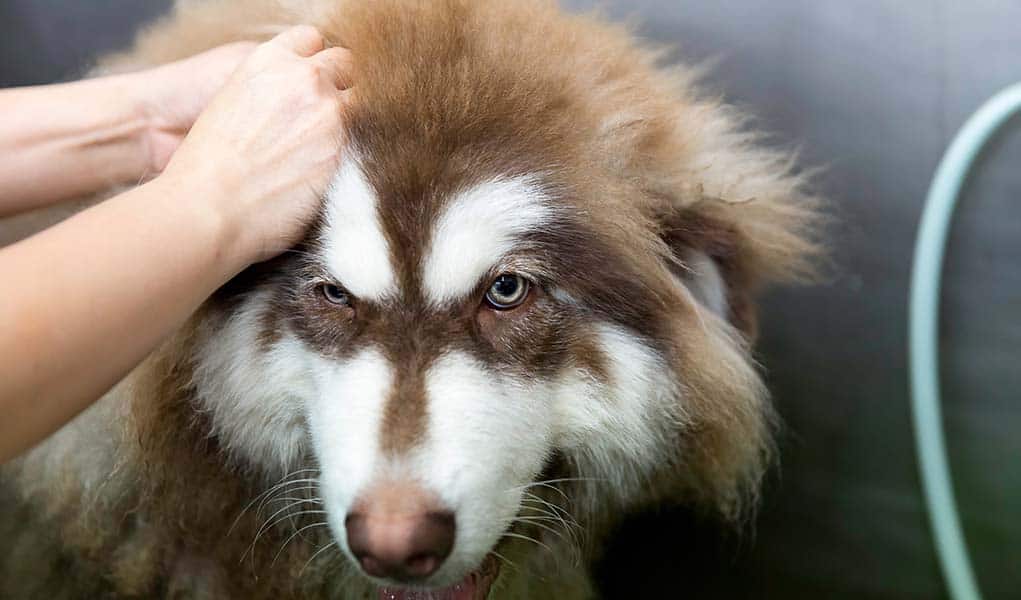A double coat has a silkier topcoat made up of guard hairs and an undercoat that is thick and fuzzy and has little shine. Collie, Sheltie, Samoyed, Husky, Malamute, Chow Chow, Great Pyranees, Saint Bernard, Pomeranian, and Keeshond are just a few of the many double coated dogs.
These coats are on many Nordic breeds due to the insulating factor of the undercoat. This is also a high-maintenance coat because it sheds heavily in the spring and fall. These coats require frequent brushing to keep matting down and keep the coat from packing.
A packed coat is hard to remove and compromises the dog’s skin, as air can’t get to the skin with all that hair so thickly packed into it. If hair can’t loft, or fluff up, it can’t dry.
If the coat is packed and it gets wet, it’s like wearing a wet wool blanket, and that can cause hypothermia. A coat that gets packed and wet takes a very long time to dry and mold can grow. A packed coat causes and hides skin irritations as well.
Areas on these dogs that need the most attention are the tail, rump, chest, and neck areas, as these are usually dense with hair and pack or mat more readily. Mats often form closely packed to the skin behind the ears in some breeds, too.
Keep in mind:
The undercoat is for insulation from cold and heat, but only if it is properly maintained and not matted. If you can’t get a comb through the coat down to the skin, the undercoat cannot do its job of insulating.
Many people think that their double-coated breed may need a summer shave-down to remove all the shedding hair. There are definite pros and cons to doing this. If the dog’s coat is matted and you can’t brush it out or demat it, then yes, a shave-down is necessary.
It is much kinder to clip the matted hair away and remove the hair than it is to demat the hair, tugging and pulling on the dog’s skin. When your dog has an extremely matted coat and you can’t decide what to do, the most humane thing to do is shave it off. The dog will be cooler, but you have to watch out for sunburn because if you shave the coat off, you may have to shave extremely close to the skin.
Keep in mind:
If you don’t routinely brush and groom dogs with thick, bushy coats, the normal shedding of skin cells is impeded and it creates an itchy layer of dandruff flakes that lies against the oily skin, making the dog smell bad and look worse. Air must get to the skin to keep it healthy.
Unless you can comb through the coat all the way to the skin, it’s not likely you will be able to use a guard comb on your clipper to cut it. Then you have to use a much shorter blade.
Undercoat is very hard to shave off evenly; it looks lumpy no matter how many times you go over it. One way to get it looking smooth is to shave the coat against the growth so you lift the coat as you clip it. Carding and removing undercoat also smoothes it.
When you shave off the coat, many dogs will scratch because they suddenly have air to the skin that wasn’t there before, and the resulting scratching can cause some bleeding and infections to begin. In addition, the topcoat grows more slowly than the undercoat, and it may take six months to a year for your dog to look normal again.
A better solution is to keep your dog on a routine of bathing, brushing, and grooming. They shed their undercoats in the springtime when the days get longer and it starts to warm up. This is nature’s way of protecting them. They keep the topcoat, and new undercoat begins to develop by fall to keep them warmer in the winter. If you can get a comb through the hair and down to the skin all over his body, at any time of year, then it’s best to leave it alone.
Many tools work well on double-coated breeds. Each dog is a little different, and you may find a tool that you prefer. Using a wide-tooth comb, followed by shedding combs, or shedding blades, rakes, or pin brushes work well on these coats.
Seasonal shedders need regular grooming so when they do blow coat, it won’t be so hard to brush out and you won’t be chasing hair bunnies around your house.
If you have a double coated dog, with a seasonally shed undercoat, you’ll spend the spring and sometimes the summer brushing and removing undercoat. Then, during an entire summer of chasing hair bunnies around your house with your best friend and constant companion – the vacuum cleaner – your newly shed dog looks about ten pounds lighter.
As the days become shorter, with less hours of daylight and cooler weather, your dog begins to look a bit heavier. Is he getting fat? No, he’s getting fluffy. His new winter undercoat is coming in to insulate him from the cold. No more heavy shedding until spring!
Tip:
Shaving the hair doesn’t prevent shedding; the dog will have much shorter hair, but shaving it off won’t stop the shedding cycle. Carding out undercoat is a much more effective way to keep your double coated dog cooler.

